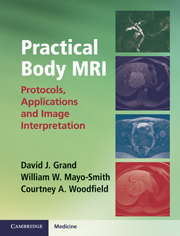Book contents
- Frontmatter
- Contents
- Preface
- To the reader
- Acknowledgments
- Glossary of terms andabbreviations used in Body MRI
- Section 1 Body MRI overview
- Section 2 Abdomen
- Section 3 Pelvis
- Chapter 7 The female pelvis: uterus
- Chapter 8 Adnexa
- Chapter 9 Female urethra
- Chapter 10 Pelvic floor / prolapse
- Chapter 11 Imaging of the pregnant patient
- Chapter 12 MRI of male pelvis
- Chapter 13 Rectal MRI
- Section 4 MRI angiography
- Index
Chapter 12 - MRI of male pelvis
from Section 3 - Pelvis
Published online by Cambridge University Press: 05 November 2012
- Frontmatter
- Contents
- Preface
- To the reader
- Acknowledgments
- Glossary of terms andabbreviations used in Body MRI
- Section 1 Body MRI overview
- Section 2 Abdomen
- Section 3 Pelvis
- Chapter 7 The female pelvis: uterus
- Chapter 8 Adnexa
- Chapter 9 Female urethra
- Chapter 10 Pelvic floor / prolapse
- Chapter 11 Imaging of the pregnant patient
- Chapter 12 MRI of male pelvis
- Chapter 13 Rectal MRI
- Section 4 MRI angiography
- Index
Summary
Male pelvis protocol: scrotum
Indications
This protocol is used for generalized screening of pelvic pathology, i.e. pain, metastatic disease, masses. It can also be adapted for evaluation of scrotal and penile pathology (see below).
IV contrast agent: 1 mmol/kg gadopentetate dimeglumine at 2 cc/s
Oral contrast agent: None
At least 24-gauge IV; connect to power injector
Have patient void just prior to start of the exam
Exam sequences
(1) Coronal T2 single-shot fast-spin echo BH – Identify T2-bright and T2-dark lesions.
(2) Sagittal T2 fast-spin echo – Identify T2-bright and T2-dark lesions.
(3) Axial T2 fast-spin echo – Identify T2-bright and T2-dark lesions.
(4) Coronal T2 fast-spin echo FS – Identify T2-bright and T2-dark lesions. Evaluate for pelvic fluid and T2-bright osseous lesions.
(5) Axial volume-interpolated gradient echo BH – If using surface coil for scrotal imaging, perform this sequence with larger field of view pelvic phased-array coil to image the pelvis from the iliac crests through the symphysis pubis.
(6) Axial volume-interpolated gradient echo BH pre-contrast.
(7) Axial volume-interpolated gradient echo BH post IV administration of contrast at 70 seconds.
(8) Sagittal volume-interpolated gradient echo BH post IV administration of contrast at ~2 min.
(9) Coronal volume-interpolated gradient echo BH post IV administration of contrast at ~3 min.
- Type
- Chapter
- Information
- Practical Body MRIProtocols, Applications and Image Interpretation, pp. 121 - 131Publisher: Cambridge University PressPrint publication year: 2012



